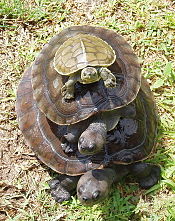Burmese roofed turtle
| Burmese roofed turtle | |
|---|---|

| |
| Female | |
| Scientific classification | |
| Domain: | Eukaryota |
| Kingdom: | Animalia |
| Phylum: | Chordata |
| Class: | Reptilia |
| Order: | Testudines |
| Suborder: | Cryptodira |
| Superfamily: | Testudinoidea |
| Family: | Geoemydidae |
| Genus: | Batagur |
| Species: | B. trivittata
|
| Binomial name | |
| Batagur trivittata | |
| Synonyms[3] | |
| |
The Burmese roofed turtle (Batagur trivittata) is one of six turtle species in the genus Batagur of the family Geoemydidae.[2] It is a freshwater turtle endemic to Myanmar and was thought to be extinct until rediscovered in 2002. Less than 10 mature individuals were known by 2018.[1]
The female Burmese roofed turtle grows significantly larger than the male; the male's usually green head transforms during the breeding season to a bright chartreuse-yellow with bold black markings.[4]
In 2007, an illegally traded individual was seen in Qingping market in Guangzhou, China.[5]
Conservation[edit]
The Burmese roofed turtle is nationally protected and listed in CITES Appendix II. The captive population in five zoos comprised about 1,000 individuals as of 2018.[1] Several hundred Burmese roofed turtles are kept in the Yadanabon Zoological Gardens in Mandalay and a turtle conservation center in Lawkananda Park, Bagan. Some have been released to the wild. In the years that followed, researchers found several specimens of the Burmese roofed turtle and took them to captivity.[6]

References[edit]
- ^ a b c d Platt, K.; Horne, B.D.; Praschag, P. (2019). "Batagur trivittata". IUCN Red List of Threatened Species. 2019: e.T10952A152044061. doi:10.2305/IUCN.UK.2019-1.RLTS.T10952A152044061.en. Retrieved 8 February 2022.
- ^ a b Rhodin, A.G.J.; van Dijk, P.P.; Inverson, J.B.; Shaffer, H.B. (2010). "Turtles of the world, 2010 update: Annotated checklist of taxonomy, synonymy, distribution and conservation status". Chelonian Research Monographs. 5: 107–108. doi:10.3854/crm.5.000.checklist.v3.2010. ISBN 978-0965354097.
- ^ Fritz, U.; Havaš, P. (2007). "Checklist of Chelonians of the World". Vertebrate Zoology. 57 (2): 226. doi:10.3897/vz.57.e30895.
- ^ Nuwer, R. (2020). "A Turtle With a Permanent Smile Was Brought Back From Extinction". The New York Times. Retrieved 2020-09-03.
- ^ Kuchling, G. (2007). "China Market: Turtle market survey in China reveals disturbing number of Myanmar endemics and critically endangered species" (PDF). Turtle Survival Alliance Newsletter (August): 8–9.
- ^ Platt, S. (2015). "Burmese Roofed Turtles Return to the Wild". Turtle Survival Alliance. Retrieved 8 February 2022.


